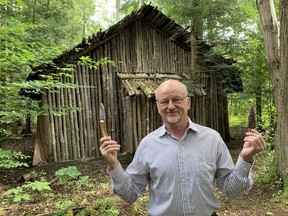Stone Age past being explored by archaeologists in Norfolk and Haldimand

Article content
Archeologists in British Columbia and Austria are taking a deep dive into the ancient past of Norfolk and Haldimand counties.
Haldimand council donated $1,000 toward the project in 2018. On Sept. 14, it was Norfolk council’s turn to follow suit.
“The north shore of Lake Erie is very unique to Stone Age people,” John Benson of Port Dover, a fundraiser for the undertaking, told Norfolk council.
“This is really the beginning of Stone Age people (in Ontario). It was the lake and the resources of the lake and the climate of the time. But the beginning of Stone Age man (in Ontario) was actually on the north shore of Lake Erie.”
Advances in technology have provided archeologists with new tools for assessing old artifacts. Benson said the focus of this research involves analyzing flint fragments – also known as chert — at the molecular level and tracing them back to known chert deposits in this part of North America.
In doing so, researchers can deduce a great deal about ancient trading routes and migratory patterns of the first people to populate south-central Ontario, said Benson.
“We’re searching for answers,” he said. “The only thing remaining of these people is the chert – the flint artifacts they left behind.”
Two of the laboratories analyzing samples are at the University of British Columbia, while the third is at the University of Vienna. The local project is in its fifth year with three to go.
Benson said Norfolk and Haldimand will figure prominently in at least six academic papers detailing the research findings.
The estimated cost of the lab work is $55,000, of which $45,500 has been raised, he said.
Council heard that several local businesses have contributed. They include Waterford Sand and Gravel ($10,000), Ferrous Recycling Services ($10,000) and Allan’s Excavating ($3,000). The Natural Sciences and Engineering Research Council of Canada has given preliminary approval to $20,000, while an anonymous donation of $1,500 also has been received.
Norfolk council was enthusiastic in its support. Councillors Linda Vandendriessche and Chris VanPaassen said Norfolk farmers have collected vast amounts of flint artifacts over the years. Vandendriessche said she looks forward to this project shedding light on the stories behind them.
“It’s something we farmers down here know a lot about – the flint and everything else,” Vandendriessche said. “We couldn’t date it but we’ve found a lot of it. I think it’s an interesting project. I think it’s a wonderful project.”
In his presentation, Benson said the era of interest spans from 9000 BC to 1000 BC.
He spoke of two spear points researchers discovered in a ginseng field. One was from the Archaic period (7000 BC to 1000 B.C.) while the other was from the Paleo-Indian period (9000 BC to 7000 BC). Benson said it is remarkable that the points, separated by about 5,000 years, were found only five feet apart.
Postmedia is committed to maintaining a lively but civil forum for discussion. Please keep comments relevant and respectful. Comments may take up to an hour to appear on the site. You will receive an email if there is a reply to your comment, an update to a thread you follow or if a user you follow comments. Visit our Community Guidelines for more information.